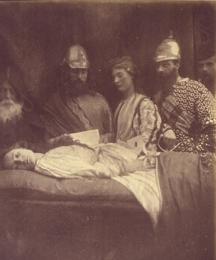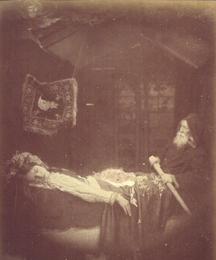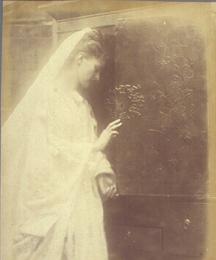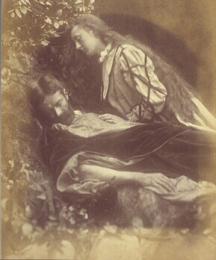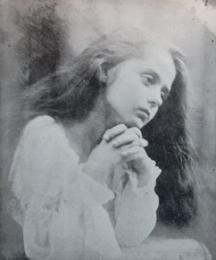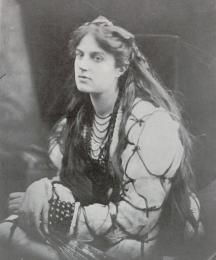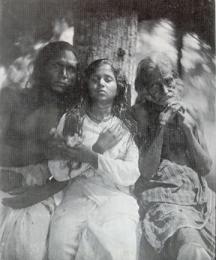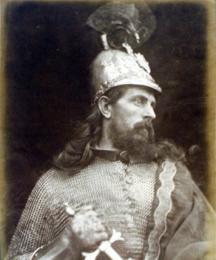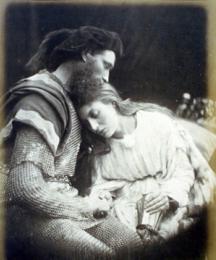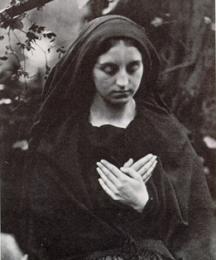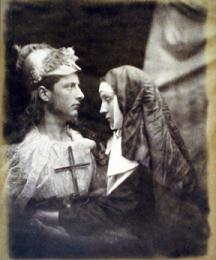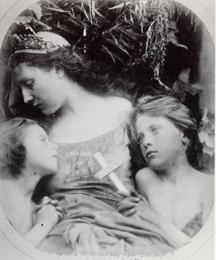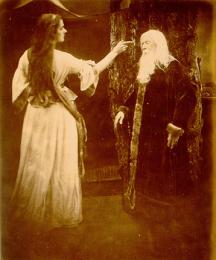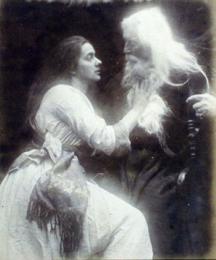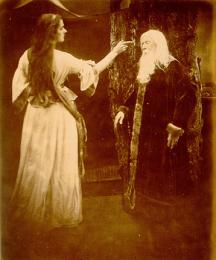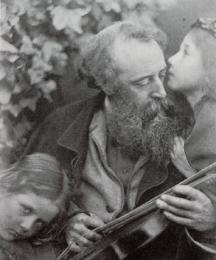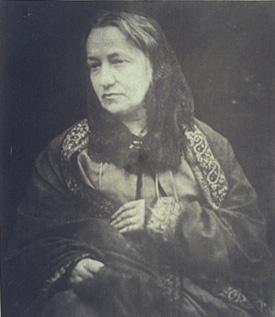
Julia Margaret Cameron
1815 - 1879Julia Margaret Pattle was born in British India, on June 11, 1815, the daughter of an official in the Bengal Civil Service and a descendant of the French aristocracy. After her early years she received an education in France and England, returning to India in 1834. Four years later, in 1838, she married Charles Hay Cameron, twenty years her senior (Lukitsh 285). In 1848, after Charles retired, he and Julia returned to England where they raised five children, adding a sixth in 1857 when they adopted Mary Ryan. Through Julia's sister, Sarah Prinsep, the new arrivals cultivated a wide circle of elite, intellectual friends. It is this company of friends, family, and servants that Cameron used as models for her "tableux vivants" (Lukitsh 286).
In the course of her lifetime Cameron would come to know of the push for women's emancipation, the end of slavery in America, and the emergence of a new medium -- photography. Through her photography, Cameron expanded on the Victorian ideal and transcended her family legacy of women noted solely for their beauty. The aristocratic salons fostered her intellectual and artistic interest, and her social position afforded her the opportunity to pursue the arts and sciences while managing an active household.
In 1860, the family business required Charles and his sons to return to Sri Lanka, at which time the remainder of the family took up residence in Freshwater, Isle of Wight. It was then that Cameron became a neighbor and close friend to Alfred Lord Tennyson and his family.
By 1863, the coffee plantations, which provided the Camerons with the time and resources to entertain, began to suffer. Charles was again called away and, in his absence, Julia received a camera from
Read More
Read Less
Julia Margaret Pattle was born in British India, on June 11, 1815, the daughter of an official in the Bengal Civil Service and a descendant of the French aristocracy. After her early years she received an education in France and England, returning to India in 1834. Four years later, in 1838, she married Charles Hay Cameron, twenty years her senior (Lukitsh 285). In 1848, after Charles retired, he and Julia returned to England where they raised five children, adding a sixth in 1857 when they adopted Mary Ryan. Through Julia's sister, Sarah Prinsep, the new arrivals cultivated a wide circle of elite, intellectual friends. It is this company of friends, family, and servants that Cameron used as models for her "tableux vivants" (Lukitsh 286).
In the course of her lifetime Cameron would come to know of the push for women's emancipation, the end of slavery in America, and the emergence of a new medium -- photography. Through her photography, Cameron expanded on the Victorian ideal and transcended her family legacy of women noted solely for their beauty. The aristocratic salons fostered her intellectual and artistic interest, and her social position afforded her the opportunity to pursue the arts and sciences while managing an active household.
In 1860, the family business required Charles and his sons to return to Sri Lanka, at which time the remainder of the family took up residence in Freshwater, Isle of Wight. It was then that Cameron became a neighbor and close friend to Alfred Lord Tennyson and his family.
By 1863, the coffee plantations, which provided the Camerons with the time and resources to entertain, began to suffer. Charles was again called away and, in his absence, Julia received a camera from her daughter and her son-in-law as a birthday gift. It is widely held that the young couple hoped to provide some diversion for her while Charles was attending to financial crises in Sri Lanka (Malcom 10). Her daughter, Julia, may have been aware of Cameron's rudimentary interest in photography when she suggested "It may amuse you, mother, to try to photograph during your solitude at Freshwater" (Malcolm 10).
Julia tried enthusiastically. The newly discovered ability of the photograph to create and document beauty triggered a fashionable interest as well as a heated debate as to whether or not the medium constituted art. Cameron's view is clearly stated in a letter to Sir John Herschel, to whom she writes, "My aspirations are to ennoble Photography and to secure for it the character and uses of High Art by combining the real and ideal sacrificing nothing of Truth by all possible devotion to Poetry and beauty" (Johnson 364).
By the year 1869, many women aspired to lives that involved less sacrifice than convention called for, and John Stuart Mill had published his feminist plea entitled On the Subjection of Women. Some maintain that Cameron was a purely Victorian woman, who held firm to the subordinate female role outlined by her Bible and society. It has been stated that her photographic collections are an indication that she "accepted maternity and marriage as high and holy offices" (Malcolm 12). Cameron maintained her matriarchal role, pursued her work, and received financial rewards as well as professional recognition while transcending conventional femininity, which required women to choose between home and career.
Her career could not have been more timely, as the coffee crops failed in Ceylon, Cameron was paid by Charles Darwin for the portraits she had produced of him. Her most highly acclaimed work included portraiture, but she also created allegorical narratives, tableaux vivants, and spiritual meditation in her photography. Her images, which often appear to have a degree of "theatricality and artificiality" (Malcom 14), offer typological interpretation of the Bible and anticipate the Pre-Raphaelite painters by one generation (Weaver 15). The soft focus, which serves as her trademark, was initially achieved by accident (Malcolm 14). While critics may look back and see a life of eccentricity and self-indulgence, it is difficult to accept claims that Cameron had not intended her family to benefit from her endeavors. In an ironic twist of fate, the thoughtful gift she had received from her daughter was to become a source of solace. In 1873, ten years after receiving her first camera, Cameron lost her first and only biological daughter, Julia. Symbolic of Cameron's quieted spirit, there are no records of any published photographs in that year. In his recollection of young Julia, Henry Taylor captures the void that Cameron's friends and family suffered. She had, he observed, "An entire simplicity, and unconscious honesty of mind...strength of understanding and clearness of purpose...resilience which is so often...regarded as a provision of Nature, and her originality took, along with other forms, the form of a determination to be commonplace" (Mozley 14).
Determination appears to have been characteristic of the Cameron women; the mother seemed to recall her daughter's gift and words, "try to photograph during your solitude," and Cameron forged ahead with her art. While the void born of her daughter's death remained, Cameron was not isolated for very long.
Cameron was surrounded by the visionary artists Lewis Carroll, Henry Wadsworth Longfellow, Dante Gabriel Rossetti, and Alfred Lord Tennyson. One of the more prominent influences in Cameron's work was Henry Peach Robinson, who believed photography should follow the artistic rules of composition for the canvas (Bogardus 101). George F. Watts encouraged her use of symbolism. The salon atmosphere of her gatherings established a degree of equality and trust between the sexes, and Cameron appears to have won the respect of her peers, despite the fact that the artistic value of photography was still widely questioned. Tennyson, before a photographic seating took place, once warned his friend in earnest, "Longfellow, you will have to do whatever she tells you. I shall return soon and see what is left of you" (Millard 188).
The "distraction" of her camera had evolved to a vocation that allowed Cameron to reflect on the issues and influence of her culture, using the medium to negotiate her own identity, and influence the destiny of others. Her portraits effectively celebrated the artists of her elite circle of friends and contributed to public recognition of men such as Henry Taylor, Sir John Herschel, and Robert Browning. While her fame seems to rest on her images of famous men, more recent analysis reveals a "more complex and enigmatic" (Malcolm 14) representation of women, suggestive of a feminist reading of her work.
Cameron's photographs show women in sharp contrast to the objectified female images previously represented in photography. Her women emanate purity through the lighting, and the fact that many of her figures appear out of focus suggests that she wished to emancipate the woman from a rigidly discounted identity. The collective woman could potentially be redefined as being free from the sins of Eve while her conventional attributes were represented permanently in the foreground. In her print "Girl Praying" (1866) one sees the child surrounded by, as well as filled with, light. The 1872 image "A Study of a Holy Family" shows a mother, almost Christ-like in her crown and bare shoulders, subdued by the cross. Additionally, the "Pensive Nun" image, in which Cameron has emblazoned a cross of light on the forehead of her subject, denotes a spiritual mind in woman -- divinely recognized -- that has historically been discounted by mortal man. The injustices done to women by patriarchal convention also resonate in the somber gaze of her "Hypatia," the scientist/physician who was killed by a Christian mob for her attempts at inclusion in the male-dominated realm.
Most significantly, Cameron sought to redeem women through England's Arthurian legend. In August, 1874, Tennyson requested that Cameron capture the sentiment of his verse in her art for The People's Edition of, The Idylls of the King. Her work captures both the text and the context of Tennyson's work, portraying the diversity of characters and representation of consequences for rigidly maintained principles, doctrines, and passions.
Although Cameron created approximately two hundred images, forty-two of which depicted The Parting of Sir Lancelot and Queen Guinevere, only two of her photographs were selected for the publication, and these were to be reproduced as woodcuts of a reduced size (Millard 188). Determined to see her creations exhibited in their full size and features, Cameron arranged for Henry S. King to publish an analogous volume entitled Illustrations to Tennyson's Idylls of the King, and Other Poems, which was produced with images made directly from her negatives in 1875 (Mozley 14).
Cameron's photographs reflect Tennyson's circumspect approach to the binary oppositions of male and female, good and evil, or true and false. As had Chaucer, these artists seek to import the duality of the individual in their art to subvert socially constructed identities and hierarchies. Cameron translated Tennyson's world of "flesh and shadow" ("The Last Tournament", 315-16) with costumes, props, and lighting to both support and subvert the stains assigned to various characters. The sequence and substance of her photographs capture the symbolism of the double-edged Arthurian sword, Excalibur, showing how men, and women, are taken up or cast away.
Cameron's illustrations are culled from the segments entitled "Gareth and Lynette", "Geraint and Enid", "Merlin and Vivien", "Lancelot and Elaine", "The Holy Grail", "Guinevere", and "The Passing of Arthur". While the actual images available in different albums vary slightly, and Cameron's choice of caption is inconsistent, each segment presented in her albums alternately questions the human failings of male and female, however, her photograph of Galahad and the Grail Maiden represents the achievement by a man and woman of a common faith in The Holy Grail.
The first illustration to the Idylls is Gareth and Lynette, which portrays a remorseful Lynette tenderly watching over Gareth. Cameron has penned the lines "Worse the being fool'd of others,/ is to fool one's self" ("Gareth and Lynette" 1242-43). This scene of nurturing provides and reinvents an identity for Lynette, who is traditionally portrayed spurning the kitchen-knave knight. The garden imagery reflects an Edenic scene, signifying woman as one with Nature and reinforcing Victorian concepts of woman as a reconciling entity.
Cameron and Tennyson both counter the initially harsh female in the first tale with the second poem entitled "Geraint and Enid". The photograph depicts Enid acquiescing to the demands of her husband with the caption, "If Enid errs, let Enid learn her fault!" ("The Marriage of Geraint", 132). Enid returns to her wardrobe, at her husbands order, for the faded silk dress that he will require her to wear. Cameron uses a soft focus and arranges for an ethereal light to fall upon the devoted and maligned wife.
The third image, Merlin and Vivien, aligns the fall of Camelot with the fall of Eden. The serpentine qualities allocated to Vivien are apparent in the lines Cameron had underscored in the volume:
And lissome Vivien, holding by his heel,
Writhed toward him, slided up his knee and sat
Behind his ankle twined her hollow feet
Together, curved an arm about his neck,
Clung like a snake; and letting her left hand
Droop from his mighty shoulder, as a leaf,
Made with her right a comb of pearl to part
The lists of such a beard as youth gone out
Had left in ashes... ("Merlin and Vivien", 236-44).
Although Vivien appears to subordinate herself to Merlin in the text, Cameron negates this servitude by enthroning Vivien in the center of the image and allowing her model's presence to all but obscure that of Merlin. The photograph also depicts the lovers/rivals in an intimate negotiation which few other illustrators have elected to highlight. (See Eleanor Fortesque Brickdale's depiction of this scene for a similar positioning).
The tension and reciprocity between man and woman is found also in the fourth image of Vivien and Merlin. This image resembles most illustrations in that the intimacy between the two is replaced with consternation and distance. Cameron captures the moment of betrayal as defined by Tennyson's lines, "Then, in one moment, she put forth the charm/ Of woven paces and of waving hands" ("Merlin and Vivien", 965-66).
The combination of these two images offers the audience alternative dynamics for the male/female relationship; they may be cooperative or oppositional. Cameron has highlighted her partially disrobed model of Vivien to signify the character's shame and guilt. Further, the placement of the two subjects affords Vivien, who appears to float above Merlin, a dominant location. From this height, Vivien extends a condemning finger at Merlin, remanding him to an ancient oak in keeping with Tennyson's text.
Cameron then depicts Elaine, the willing victim of love who, although in great contrast to Vivien, is equally self-serving and willful in her passions. In this particular image, the despondent Elaine rests beside the cover she had woven for Lancelot's shield. The cover, to which Elaine had added a border of branch, flower and yellow-throated nestling, is a metaphor for the romantic fantasy she had constructed around Lancelot in her mind. Left only with the remnant of her own work, Elaine sings her "Song of Love and Death" ("Lancelot and Elaine", 997). Cameron portrays Elaine as one resigned to be cast away, a woman possessed by the rapture of passion. The art of photography imitates other forms of art in that Cameron etched the branch, flower, and bird designs of the shield cover directly onto her glass plate negative. The illusion devised with her camera and equipment also signifies the manner in which humans willfully impose their vision on reality.
The consequences of unrequited passion are evidenced in Cameron's image of Elaine in the barge, a scene in which the cover of Lancelot's shield hovers above the corpse. Cameron arranges the drastic contrast between the singing Elaine of the former image and the now silent maiden being rowed away.
Silence engulfs Arthur, Guinevere, and Lancelot as they confront the cost of passion in Elaine at Camelot, in which the lifeless Elaine rests under their gaze. Cameron echoes this silence with the absence of any caption. She also arranges for the male characters to be consigned to the shadows, while the lighting and centrality of the women establishes a bond between Guinevere and Elaine. This scene seems to speak subtly to Cameron's own sense of loss regarding her late daughter, and to the photographer's affection, empathy, and admiration for her own sex.
The contributions of women, which have been absent in many illustrations of the legend, are highlighted further in Cameron's visual adaptation of "The Holy Grail". Traditionally, this segment is depicted with Galahad and the Grail, or the relationship between Galahad and the Nun shows the latter as a subordinate through placement and lighting. Some of these representations include "The Golden Girdle" by Ernest Chapman, "Galahad and Percival's Sister" by Lancelot Speed, "The Communion of the Holy Grail" by Franz Stassen. Cameron has placed the two side by side, identifying marriage as an achievement of shared faith, beneficence, and agency.
The passion of this woman is a "deathless passion" ("The Holy Grail", 163) which removes her from the mortal realm of flesh and shadows. Although Arthur recognizes that there is none holier than she, he defines the nun's significance as "a sign to maim this Order which I made" ("The Holy Grail", 296-97). Ironically, it is the mortal passion of Camelot's most renowned woman, Guinevere, that is framed as the greatest stain on Arthur's Order.
Arthur's earthly queen appears to have found no happiness in her sin in "The Parting of Lancelot and Guinevere." The queen and the once stainless knight, Lancelot, are cast in partial darkness, and the costume, pose, and lighting convey the doom that hovers over the lovers. Lancelot, in profile, is cloaked in shadows to suggest the dark aspect of his nature that is often overlooked. Although Guinevere is also shown in partial profile, she is made to appear the victim of a greater force. The placement of hands shows that the two have acted in concert, but the queen is dressed in white, bathed in light, and bent under the will of her lover. The pose emphasizes the concept that Guinevere was the pawn that society required women -- even a queen -- to be. Cameron reveals Guinevere as a soul struggling to maintain her vows and innocence, and the harmony of Camelot, where the dominance of the male is unquestioned. The attendant lines detail the queen's repeated plea; "Passion-pale they met and greeted.../ O Lancelot, if thou love me get thee hence./ And Lancelot ever promised, but remained..." ("Guinevere", 92-8 as arranged by Cameron).
The consequences of Guinevere's indiscretion are witnessed in Cameron's next image, Guinevere and the Novice. Cameron has placed the queen on a different form of throne, and her rigid stance and remote glance reflect her loss of all joy. It is possible that Cameron's personal sense of loss regarding her late daughter is revealed in the abyss that resides between the two females in the photograph. The solace Cameron found in children, her absent daughter in particular, seems to be underscored with lines culled from the Guinevere section of the text; "But communed only with the little maid,/ Who pleased her with a babbling heedlessness" ("Guinevere", 148-9).
The next image to be presented is that of King Arthur. In his helmet, a "golden dragon sparkling over all" ("Holy Grail", 263), Cameron has captured Tennyson's sense that Arthur has not made his "high place the lawless perch/ Of wing'd ambitions, nor a vantage-ground/ for pleasure" ("Dedication", 21-3). Concurrently, the image accentuates the remoteness of the stainless King, that aspect of the man which Guinevere perceived to be "cold,/ High, self-contained, and passionless" ("Guinevere", 402-3). Arthur's majesty makes the queen's observation that one "who loves me must have a touch of earth" ("Lancelot and Elaine", 133) understandable. The photographer noted the following words from Tennyson's poems to highlight the difference between the immortal man and his mortal wife: "And even then he turned.../who seemed the phantom of a giant" ("Guinevere", 596,598).
Cameron's final image of The Passing of Arthur does not make the King central to the photograph; Cameron bears the king "to the margin" ("The Passing of Arthur", 333), where he lay "like a shatter'd column" ("The Passing of Arthur", 389). The dying Arthur is not "companionless" ("The Passing of Arthur", 404) as he is attended by the three Queens. Behind these women stand robed, stately forms, who hide their foreheads and eyes, have turned their backs to the King. All, save the three Queens, are subordinated in relation to Arthur by shadows, darkness, and strength of will. The women appear to be "the Powers who walk the world" ("The Coming of Arthur", 106) and seem "clothed in living light" ("The Passing of Arthur", 454). They attend to his needs and celebrate the role of women as nurturers and healers, bringing the imagery of Cameron's illustrations full circle. The scene of Lynette's mortal skill in nurturing Gareth that began the collection is balanced by this concluding image of supernatural restoration. The intimacy Cameron has arranged between this man and these women suggests something immortal, not only in the characters, but in the relationship between men and women. The cross of the vessel, a visual that Cameron achieved by making masts out of broomsticks (Malcolm, 14), signifies the journey of the once and future king, perpetuating the Arthurian myth and Christian ideology. Cameron's image of the king is attended by Arthur's decree: "King I am, whatsoever be their cry." ("The Passing of Arthur", 162)
Cameron's photographs for Tennyson's Idylls were not well received by her contemporary critics: Clive Bell admonished her for "trying to make a photograph look like a picture" and Roger Fry stated that they were "failures from an aesthetic standpoint" (Millett 201). An even more harsh critique came from Helmut Gernsheim, who stated that Cameron failed to recognize the limitations of the medium, and that "the Pre-Raphaelites dedicated some of their best work to Tennyson -- Mrs. Cameron, some of her worst" (Millett 201). Despite misgivings over artistic application of the new medium and Cameron's skill, her work on the Idylls reflects a powerful new form of imaging that brought the legends of Camelot into a new light.
The "dirty nurse, experience" ( "The Last Tournament", 317) had taught Cameron, specifically through her relationship with Charles, that a unified realm requires one will. In 1879, in compliance with Charles' wish to end his earthly days among his sons, Julia reluctantly returned to India. In Ceylon, Cameron briefly continued her craft on a lesser scale, capturing images of the plantation workers and regional women before falling fatally ill. Her great-niece, Virginia Woolf, depicted Cameron's final moments, stating that the photographer "lying before an open window saw the stars shining, breathed the one word 'Beautiful'" (Mozley 17).
While many discount Cameron's work as melodramatic or amateurish, her artistic applications expanded on the documentary uses of the photographic medium. The contributions of this muse, are an enchanting legacy showing that "the goal of this great world lies beyond sight" ("To the Queen", 59-60).
The University of California, Wellesley, the Rhode Island School of Design, and Harvard are only a few of the institutions which have internal electronic galleries of Cameron's work. The Royal Photographic Society owns approximately 800 of her albumen and carbon prints in addition to a handwritten manuscript of her autobiography. The George Eastman House is in possession of some of Cameron's equipment, and also offers an extensive online gallery of Cameron's photography. The Cameron Trust, an extensive and permanent gallery, enables one to view Dimbola, Cameron's home in England on the Isle of Wight, as well as a small electronic gallery of Cameron's work.
Links to other sites pertaining to Julia Margaret Cameron
The George Eastman House
Julia Margaret Cameron Trust
Wellesley College
MFA Boston
Stanford
Getty Collection
Claremont Scripps Collection
CAMERON'S WRITINGS
Leonora, Translated by Julia Margaret Cameron. Illustrations by Daniel Maclise. London, Gottfried August Bürger, 1847.
"Annals of My Glass House." Written by Julia Margaret Cameron in 1874; published in Photographic Journal L1(N.S.) (July 1927): 296-301.
"On a Portrait." Written by Julia Margaret Cameron. Dated September, 1875; published Macmillan's Magazine, 33 (Feb. 1876): 372.
Sources
Armstrong, Nancy. "Modernism's Iconophobia and What it Did to Gender." Modernism/Modernity 5.2 (1998): 47-75.
Bogardus, Ralph F. Pictures and Texts. Ann Arbor, Michigan: UMI Research Press, 1984.
Cameron, Julia Margaret Pattle. Illustrations to Tennyson's Idylls of the King, and other Poems. London: Henry S. King, 1875.
Johnson, William S., Mark Rice, and Carla Williams. Photography: From 1838 to Today, George Eastman House, Rochester, NY Koln; New York: Tashen, 1999.
Lukitsh, Joanne. "'Simply Pictures of Peasants': Artistry, Anthropology, and Ideology in Julia Margaret Cameron's Photography in Sri Lanka." The Yale Journal of Criticism 9.2 (1996): 283-308.
Malcolm, Janet. "The Genius of the Glass House." The New York Review. 4 Feb 1999: 10-15.
Millard, Charles W. "Julia Margaret Cameron and Tennyson's 'Idylls of the King'" in the Harvard Library Bulletin. 21.2 (April 1973): 187-201.
Mozley, Anita Ventura. "Mrs. Cameron's Photographs from the Life." Palo Alto: Stanford University Museum of Art, 1974.
Tennyson, Lord Alfred. Idylls of the King. London: Penguin, 1983.
Walch, Peter. For My Beloved Sister, Mia. University of New Mexico Art Museum, 1994.
Weaver, Mike. Whisper of the Muse. Malibu: J. Paul Getty Museum, 1986.
Weaver, Mike. Julia Margaret Cameron: 1815-1879. London: The Herbert Press, Ltd., 1984.
Read Less

